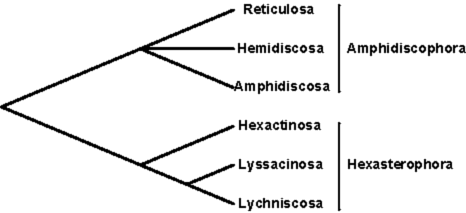



Hexactinellida: Fossil Record
 |
The oldest fossil sponge known is a hexactinellid. In 1996, Gehling and Rigby identified and described the oldest probable sponge, Paleophragmodictya (shown to the left) from the Vendian (or Ediacaran) of South Australia. Their specimens revealed a reticulating net of spicules (as seen to the right) in the sponge body wall, reminiscent of that seen in many hexactinellid sponges. By the Cambrian, relatively simple forms are known world-wide. Hexactinellids probably achieved their maximum diversity during the Cretaceous. Roughly 300 fossil genera are known. |
 |
 The Amphidiscophora is the older of the two main groups of Hexactinellids, with one of its subgroups, the Reticulosa, known from the Vendian through the Permian. The Reticulosa includes the most simple hexactinellids, the Protospongoidea, which possessed just a single dermal layer of spicules. A second amphidiscophoran group, the Hemidiscosa, consisting of just a couple of genera, is known from the Carboniferous and the Cretaceous. A third group of the Amphidiscophora, the Amphidiscosa, is known from the Ordovician and is still present today. The Hexasterophora appeared in the Ordovician and is also separated into three main groups, the Lyssacinosa, the Hexactinosa, and the Lychniscosa, all of which have living representatives in the seas today. The members of Hexasterophora have skeletons composed of overlapping six-rayed spicules. The three groups are differentiated by the extent of fusion of adjacent spicules. The Lyssacinosa, Hexactinosa, and Lychniscosa appear sequentially in the fossil record. The least fused group, the Lyssacinosa, appears in the Ordovician, while the intermediate group, the Hexactinosa is known from the Devonian. Finally, the Lychniscosa, with the most tightly interlocking spicules is first found in rocks of Triassic age. Having noted this possible example of a progressive evolutionary trend toward greater complexity, it should be mentioned that neither of the more simple groups has been driven extinct, making it difficult to argue that greater complexity has been selected for. |


